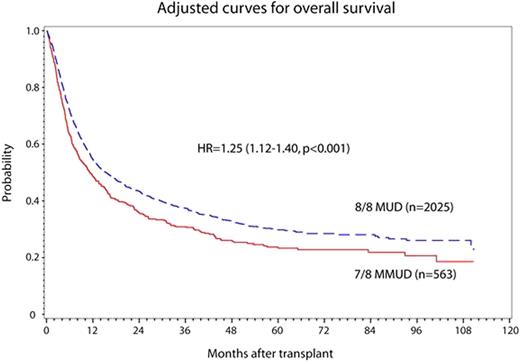Abstract
In myeloablative unrelated donor allogeneic hematopoietic cell transplantation (HCT) a 1-locus HLA-mismatch (-A, -B, -C, -DRB1) is associated with lower survival compared to fully matched pairs. However data in reduced-intensity and non-myeloablative conditioning (together called RIC) HCT are limited.
We analyzed adult AML/ALL/CML/MDS recipients of first 8/8 HLA-matched or 1-locus mismatched unrelated donor (MUD, MMUD) RIC HCT performed in the period 1999-2011 and registered in the CIBMTR. HLA-A, -B, -C and -DRB1 loci were typed in all pairs at high resolution; -DQB1 and -DPB1 loci could not be evaluated in all pairs. Transplants involving ex-vivo T-cell depletion, CD34+ selection, or post-transplant cyclophosphamide were excluded. Overall survival (OS) was the primary outcome. Secondary outcomes included non-relapse mortality (NRM), relapse, disease-free survival (DFS) and acute and chronic GVHD. Individual locus mismatch was also assessed. Apart from HLA matching, variables related to patient (age, race, sex, KPS, diagnosis, disease-risk), donor (age, parity), both (sex match/ABO match/CMV match) treatment (conditioning intensity, TBI use, in-vivo T-cell depletion (ATG), graft source (PB, BM) and GVHD prophylaxis (CyA-, Tac-based)) were considered.
2588 RIC HCT (8/8 MUD: 2025; 7/8 MMUD: 563) from 144 centers and 12 countries were analyzed. Median follow up in 8/8 MUD and 7/8 MMUD was 38 and 48 months respectively. Diagnoses were AML (65%), ALL (8%), CML (7%), MDS (20%). Conditioning intensity was RIC (79%), NMA (21%). 58% received in-vivo T-cell depletion. Graft source was PBSC (85%), BM (15%). GVHD prophylaxis was Tac-based (70%), CyA-based (27%). Mismatches involved HLA-A (188), -B (81), -C (219), and -DRB1 (75); with -DPB1 and -DQB1 typing available in 1382 and 2502 cases respectively.
Compared to 8/8 MUD, 7/8 MMUD recipients were more likely to be younger and ethnic minorities and to have older and parous donors. In univariate analyses DQB1- and -DPB1 mismatch was not associated with worse OS, DFS, or NRM and was not further evaluated. There was a trend toward more grade II-IV acute GVHD in -DPB1 double (p=0.02) but not single mismatches. In multivariate models 7/8 MMUD RIC HCT had worse grade II-IV and III-IV acute GVHD, NRM, DFS and OS, but not relapse or chronic GVHD (Table). No significant interactions were identified between degree of HLA matching and other clinical variables. Adjusted 1- and 3-year NRM for 8/8 MUD vs. 7/8 MMUD was 20.4% vs. 28.9% (p<0.0001) and 29.2% vs. 38.1% (p<0.0007) respectively. Adjusted 1- and 3-year OS was 54.7% vs. 48.8% (p=0.01) and 37.4% vs. 30.9% (p=0.005) respectively (Figure). There was no difference between allele and antigen mismatches. HLA-A, -B, -C, and -DRB1 locus mismatches were each associated with 1 or more impaired outcomes (acute GVHD, NRM, DFS, and/or OS).
| 7/8 vs. 8/8 HLA . | HR (95% CI) . | p-value . |
|---|---|---|
| Acute GVHD II-IV | 1.29 (1.09-1.53) | 0.003 |
| Acute GVHD III-IV | 1.69 (1.00-3.36) | 0.05 |
| Chronic GVHD | 1.11 (0.96-1.28) | 0.15 |
| Relapse | 1.01 (0.87-1.17) | 0.92 |
| NRM | 1.52 (1.29-1.79) | <0.0001 |
| DFS | 1.20 (1.07-1.34) | 0.0015 |
| OS | 1.25 (1.11-1.40) | 0.0001 |
| 7/8 vs. 8/8 HLA . | HR (95% CI) . | p-value . |
|---|---|---|
| Acute GVHD II-IV | 1.29 (1.09-1.53) | 0.003 |
| Acute GVHD III-IV | 1.69 (1.00-3.36) | 0.05 |
| Chronic GVHD | 1.11 (0.96-1.28) | 0.15 |
| Relapse | 1.01 (0.87-1.17) | 0.92 |
| NRM | 1.52 (1.29-1.79) | <0.0001 |
| DFS | 1.20 (1.07-1.34) | 0.0015 |
| OS | 1.25 (1.11-1.40) | 0.0001 |
No relevant conflicts of interest to declare.
Author notes
Asterisk with author names denotes non-ASH members.


This feature is available to Subscribers Only
Sign In or Create an Account Close Modal